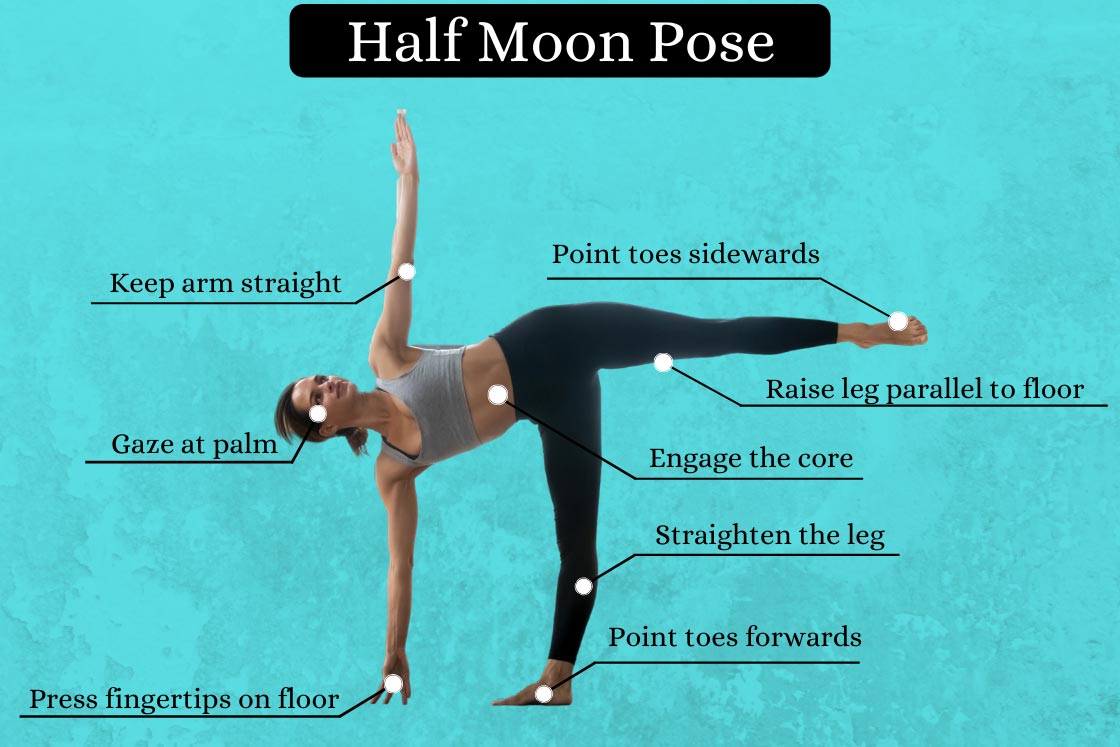Muscles Used In Half Moon Pose | Engaging these muscles acts to lift, rotate and stabilize the pelvis on the side of the lifted leg (in a fashion similar to what we learned with the trendelenberg test). This posture opens the hips and strengthens the ankles, knees and lower body. This pose stimulates the torso organs. And helps to cure enlargement of the liver and spleen. The sanskrit word chandra is often translated simply as moon, and actually has a much richer meaning.
It also abducts the femur. In sanskrit, ardha = half, chandra = moon or luminous. When i first started practicing yoga, ardha chandrasana (half moon) was the most challenging pose for me. Half moon pose is a standing balancing pose. The ardha chandrasana or the half moon pose is a great.

The backs of the legs are opened, and the paraspinal muscles extend and are strengthened. It increases the flexibility of the spine comprehensively, from coccyx to neck; Picture a half moon in the sky, as you hold your limbs on the same plane and focus on each breath. Revolved half moon strengthens and stretches the whole body. Half moon pose (ardha = half, chandra = moon asana = pose) is an energetically expansive posture that asks us to radiate out in all directions like the moon's luminescence in the night sky. And helps to cure enlargement of the liver and spleen. A fairly tricky balancing pose, ardha chandrasana strengthens the legs, ankles and feet, as well as the core. When i first started practicing yoga, ardha chandrasana (half moon) was the most challenging pose for me. The halfmoon pose is challenging due to its demand on the strength and flexibility of the legs, as well as on you ability to balance and stay focused. Benefits of revolved half moon pose. It tones the abdomen, buttocks, thighs and hips. This intense backbend tones the kidneys and liver. Female muscles ardha chandrasana (half moon pose) · about the pose:
The toes should be pointing to the side with the foot flexed and the leg should be in line with the spine, rather than moving to the back of the body. This pose has a strong impact on your chest and abdomen, thighs, ankles and spine. The half moon pose challenges every part of your body and increases flexibility by strengthening the muscles in your arms, legs, and core. This graceful standing balancing pose mirrors the image of the half moon and hence the name half moon pose (ardha chandrasana). Turn the back foot outwards and open the hip.

The hamstring muscles are stretched (the biceps femoris, semitendinosus and the semimembranosus). Keeping your half moon pose safe requires listening acutely to your body. This asana gives a good stretch to the lower back muscles. It is known to bestow strength and stability to leg and ankle. Use pigeon pose on your belly, forward fold and bridge, followed by a reclined twist to help unwind your half moon and stretch out your core, glutes, and hips. The sanskrit word chandra is often translated simply as moon, and actually has a much richer meaning. The body resembles the shape of a crescent moon. When i first started practicing yoga, ardha chandrasana (half moon) was the most challenging pose for me. Press down strongly through the mound of your big toe and engage the muscles of your. Benefits of revolved half moon pose. The revolving half moon pose balancing twist involves a. Next, i use sequential muscular engagement to lift the back leg in revolved half moon pose, beginning with the hip abductors of the standing leg. Engaging these muscles acts to lift, rotate and stabilize the pelvis on the side of the lifted leg (in a fashion similar to what we learned with the trendelenberg test).
The revolving half moon pose balancing twist involves a. When you exhale, straighten your left leg and lift it up as if you are performing triangle pose in the air, extending through your left heel. The primary muscles strengthened in this pose are the front and back leg quadriceps (thighs) and the back leg gluteal muscles. It helps to elongate the muscles of the spine and increases neck mobility. It increases the flexibility of the spine comprehensively, from coccyx to neck;

In sanskrit, parivrtta means revolved, ardha means half, chandra means the moon and asana means a yoga posture. Benefits of revolved half moon pose. Revolved half moon strengthens and stretches the whole body. The sanskrit word chandra is often translated simply as moon, and actually has a much richer meaning. Half moon pose is a standing, balancing posture that challenges the core strength. This half moon pose will give you a wonderful sense of balance and alignment, as it strengthens your legs, hips and core. Half moon pose strengthens every muscle in the body's core, especially in the abdomen, and flexes and strengthens the latissimus dorsi, oblique, deltoid and trapezious muscles. In a pose like ardha chandrasana (half moon pose), the extension of your torso in one direction and the uplifted leg in the other draws a line that represents the flat edge of a half moon, while the energy in your extended arms and standing leg radiate out like beams in the night sky. From a kneeling position, step the right foot forward with the knee bent so that the right thigh is parallel to the floor. The backs of the legs are opened, and the paraspinal muscles extend and are strengthened. If our core and thigh muscles are not engaged, your back will not be safe. This asana gives a good stretch to the lower back muscles. The half moon pose opens up the chests and shoulders and stretches the groin muscles.
Muscles Used In Half Moon Pose: It builds strength in the ankles, thighs, abdomen, buttocks, and lower back.
0 comments:
Post a Comment